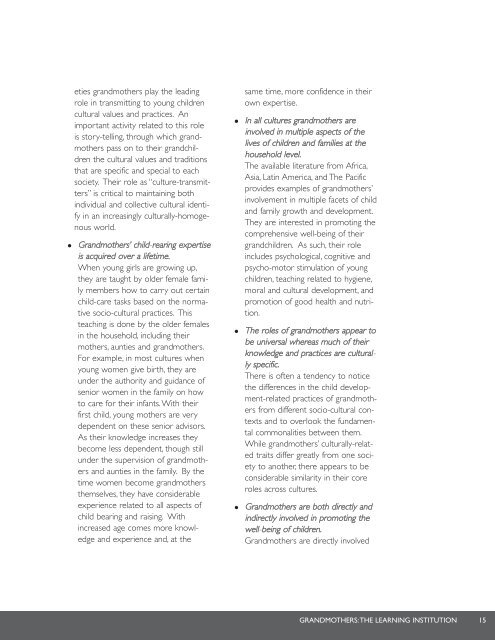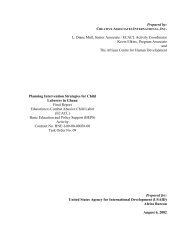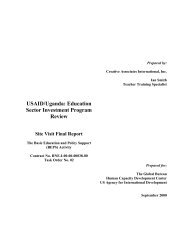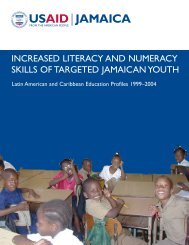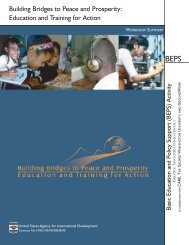“The status of eldersin traditional societiesreflects the fundamentalrole theyplay in the functioning<strong>and</strong> survival ofthose societies.”FugelsangAbout Underst<strong>and</strong>ing:Ideas <strong>and</strong>Observations onCross-CulturalUnderst<strong>and</strong>ingers. She laments the fact that these seniorwomen have generally been excludedfrom health, nutrition, <strong>and</strong> childrearing programsoften on the pretense that they areilliterate.The literature reviewed above shows thatin numerous non-western cultures inAfrica, Asia, Latin America <strong>and</strong> The Pacific,as well as in indigenous cultures in NorthAmerica <strong>and</strong> Australia, gr<strong>and</strong>mothers playa significant role in children’s health <strong>and</strong>development. Based on this review, thefollowing section is a discussion of a seriesof core roles of gr<strong>and</strong>mothers that wouldappear to be universal.CORE ROLES OFGRANDMOTHERS ACROSSCULTURESBased on a synthesis of the literaturereviewed above, as well as that included inAppendix B., on gr<strong>and</strong>mothers’ roles inchild development in different non-westernsocieties, several conclusions emergerelated to a series of core roles <strong>and</strong>expectations of gr<strong>and</strong>mothers that appearto be common across these cultures.While the focus of our discussion is on therole of “gr<strong>and</strong>mothers” given their genderrelatedspecialization in child developmentissues, in some cases the core roles <strong>and</strong>expectations refer more broadly to therole of “gr<strong>and</strong>parents.” The core roles <strong>and</strong>expectations identified across cultures areas follows:• All cultures recognize the critical roleof gr<strong>and</strong>parents as guides <strong>and</strong> advisorsto younger generations.Family members expect gr<strong>and</strong>parentsto play a role in teaching, guiding, <strong>and</strong>advising the younger generations.Resonating Margaret Mead’s words,gr<strong>and</strong>parents are expected to passonto the next generation the“model” for how things should bedone whether it is in Nepal,Colombia, or Nigeria. Furthermore,in virtually all of the non-western culturesrepresented in the reviewed literature,age <strong>and</strong> experience are valued<strong>and</strong> family members are expectedto show respect for the status<strong>and</strong> advice of gr<strong>and</strong>parents.• In all cultures gr<strong>and</strong>parents play gender-specificroles related to childdevelopment.In all societies, different roles are designatedto gr<strong>and</strong>fathers <strong>and</strong> to gr<strong>and</strong>mothers,just as gender-specific rolesare assigned to younger men <strong>and</strong>women. Senior women have primaryresponsibility for socializing youngerfemales to their role in the family <strong>and</strong>society, while senior men have analogousresponsibility for providing informaltraining to male family membersonce they pass childhood, often fromthe age of seven or eight. While inall cases gr<strong>and</strong>mothers are moreinvolved in the care of children <strong>and</strong>women in the family than are gr<strong>and</strong>fathers,given their lifetime experience,the degree of involvement ofgr<strong>and</strong>fathers in childcare varies considerablyfrom one society to another.• <strong>Gr<strong>and</strong>mothers</strong> are responsible fortransmitting cultural valuesWhile gr<strong>and</strong>fathers too, are involvedin this important task, in most soci14 UNITED STATES AGENCY FOR INTERNATIONAL DEVELOPMENT
eties gr<strong>and</strong>mothers play the leadingrole in transmitting to young childrencultural values <strong>and</strong> practices. Animportant activity related to this roleis story-telling, through which gr<strong>and</strong>motherspass on to their gr<strong>and</strong>childrenthe cultural values <strong>and</strong> traditionsthat are specific <strong>and</strong> special to eachsociety. Their role as “culture-transmitters”is critical to maintaining bothindividual <strong>and</strong> collective cultural identifyin an increasingly culturally-homogenousworld.• <strong>Gr<strong>and</strong>mothers</strong>’ child-rearing expertiseis acquired over a lifetime.When young girls are growing up,they are taught by older female familymembers how to carry out certainchild-care tasks based on the normativesocio-cultural practices. Thisteaching is done by the older femalesin the household, including theirmothers, aunties <strong>and</strong> gr<strong>and</strong>mothers.For example, in most cultures whenyoung women give birth, they areunder the authority <strong>and</strong> guidance ofsenior women in the family on howto care for their infants.With theirfirst child, young mothers are verydependent on these senior advisors.As their knowledge increases theybecome less dependent, though stillunder the supervision of gr<strong>and</strong>mothers<strong>and</strong> aunties in the family. By thetime women become gr<strong>and</strong>mothersthemselves, they have considerableexperience related to all aspects ofchild bearing <strong>and</strong> raising. Withincreased age comes more knowledge<strong>and</strong> experience <strong>and</strong>, at thesame time, more confidence in theirown expertise.• In all cultures gr<strong>and</strong>mothers areinvolved in multiple aspects of thelives of children <strong>and</strong> families at thehousehold level.The available literature from Africa,Asia, Latin America, <strong>and</strong> The Pacificprovides examples of gr<strong>and</strong>mothers’involvement in multiple facets of child<strong>and</strong> family growth <strong>and</strong> development.They are interested in promoting thecomprehensive well-being of theirgr<strong>and</strong>children. As such, their roleincludes psychological, cognitive <strong>and</strong>psycho-motor stimulation of youngchildren, teaching related to hygiene,moral <strong>and</strong> cultural development, <strong>and</strong>promotion of good health <strong>and</strong> nutrition.• The roles of gr<strong>and</strong>mothers appear tobe universal whereas much of theirknowledge <strong>and</strong> practices are culturallyspecific.There is often a tendency to noticethe differences in the child development-relatedpractices of gr<strong>and</strong>mothersfrom different socio-cultural contexts<strong>and</strong> to overlook the fundamentalcommonalities between them.While gr<strong>and</strong>mothers’ culturally-relatedtraits differ greatly from one societyto another, there appears to beconsiderable similarity in their coreroles across cultures.• <strong>Gr<strong>and</strong>mothers</strong> are both directly <strong>and</strong>indirectly involved in promoting thewell-being of children.<strong>Gr<strong>and</strong>mothers</strong> are directly involvedGRANDMOTHERS:THE LEARNING INSTITUTION15
- Page 1 and 2: GRANDMOTHERS:A LEARNING INSTITUTION
- Page 3: GRANDMOTHERS:A LEARNING INSTITUTION
- Page 11 and 12: EXECUTIVE SUMMARYSociety itself fai
- Page 13 and 14: Education, the Bernard Van LeerFoun
- Page 15 and 16: SEVERAL FACTORS CONTRIBUTE TO THELI
- Page 17: - Who am I? Assign children to askf
- Page 20 and 21: in educational activities on home t
- Page 22 and 23: “A grandmother’s understandingo
- Page 24 and 25: “Culture tells peoplehow to view
- Page 26 and 27: attention given to grandmothers’
- Page 28 and 29: social work, including family syste
- Page 30 and 31: mation from Azerbaijan (McNulty 200
- Page 34 and 35: “As women, thegrandmothers haveli
- Page 36 and 37: members often consult the moreexper
- Page 38 and 39: “Social capital is a community’
- Page 40 and 41: In a collaborative effort between
- Page 42 and 43: in-laws and the additional free tim
- Page 44 and 45: "Involving grandmothersin community
- Page 50 and 51: CULTURALLY-ADAPTED EDUCATIONMATERIA
- Page 52 and 53: strated the power of participatory
- Page 54 and 55: effects of the new ideas, their con
- Page 57 and 58: V. GRANDMOTHERS: A LEARNING INSTITU
- Page 59 and 60: Many health and development workers
- Page 61 and 62: VI. RECOMMENDATIONS FORBASIC EDUCAT
- Page 63 and 64: parents themselves did not go to sc
- Page 65 and 66: community ties by increasing teache
- Page 67 and 68: of millions. On the other hand, som
- Page 69: teachers, teacher abuse of children
- Page 73 and 74: APPENDIX B:ANNOTATEDREFERENCES ON T
- Page 75 and 76: acceptable for younger women to mak
- Page 77 and 78: showed that men are not directly in
- Page 79 and 80: ecause they had more time to devote
- Page 81 and 82: matrilineal or patrilineal areas
- Page 83 and 84:
diet, work, fetal development, sexu
- Page 85 and 86:
in the family and social networks.
- Page 87 and 88:
elated, for example, to early child
- Page 89 and 90:
REFERENCESAdams, A. M., S. Madhavan
- Page 91 and 92:
BASICS and LINKAGES. 1998. Influenc
- Page 93 and 94:
Childhood Education and Development
- Page 95 and 96:
Krishna, A. and N. Uphoff. June 199
- Page 97 and 98:
Sear, R., R. Mace, and I. A. McGreg
- Page 99 and 100:
ABOUT THE AUTHORThis review was pre


